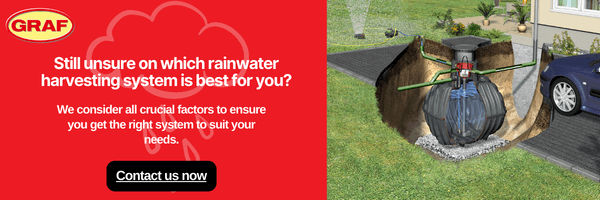When you know what size of tank is required from the tank size calculation, there are then several options on the market supplied in the UK. Many manufactured in the UK, some imported from Germany and other European countries, and many different shapes and options to suit different specific applications.
One first important consideration is the ground water level on the site that you are going to be installing the system. So how high is the water table underneath the ground? There are low profile shallow tanks specifically manufactured for this reason and application which can be completely submerged in ground water and still work and can still be guaranteed by manufacturers to stay in the ground, even though the pressure of the ground water surrounding the tank in the wrong situation with the wrong tank could cause the tank to pop up out the ground. When tanks are installed in ground water, they normally have some holes going through the tank vertically, and they are normally surrounded by gravel so that the ground water can surround the tank and pass up through it, and not build up pressure from underneath and around the sides which pushes against the tank and causes it to go upwards. When the ground water table is high it’s important to design the drainage around the tank to try and remove that groundwater from being immediately around the tank if possible, and often perforated pipe is used for this in a circular position around the tank to collect it. The groundwater goes into this pipe and is taken away either to the nearest drainage point or somewhere ideally several metres away from the tank, where the flow of water can be directed away from the tank to reduce any risk and build-up of water immediately surrounding the tank. Another important consideration is whether the rainwater harvesting tank you choose requires a concrete backfill or a granular gravel backfill. Sometimes this depends on the type of tank, or the depth in which the tank is being installed, and it can depend on the loading which is going to be imposed on top of the tank. So, if it was going to be installed in a driveway, or access road, or car park on certain developments, or whether it’s just going to be in the garden, these different things have to be considered. Tanks that require a concrete surround will take longer to install and often installation costs are more expensive due to this additional time, and due to the cost of the concrete in the first place. Tanks that require a gravel surround can generally be installed in half a day or 1 day, depending on the size of the tank and whether you have all the equipment available at the same and right time. But because the gravel can simply be backfilled and compacted in layers as you go up you don’t have to wait for concrete to go off and set, it’s a much quicker process. It’s important though that installation instructions are followed so that manufacturer’s warranties will still be in place once the tank has been installed. Many tanks are provided with 15+ years manufacturer’s warranties, but all of which would be void if their installation instructions are not adhered to so it’s important that if you’re installing the tank, or your builder or contractors are, that these instructions are followed to the letter to make sure that the responsibility lies with the manufacturers even once the tank is in the ground.
Before we move away from ground water, some cylindrical tanks that go deeper in the ground are typically groundwater stable up to the half-way point on the tank, so even if the ground water is 1.5m to 2m below the surface it’s still important to consider which tank is suitable in this scenario. There are many low-profile tanks available now, which are shallow tanks that only require around 1m to 1.5m total excavation depth. These will always assist with high ground water table installations but it’s still important to check where the groundwater level can come up to when installing these shallow tanks because different manufacturers will have different stipulations. Another important consideration on the type of tank is whether the filter is an internal integral part of the tank or whether it doesn’t go in the tank at all and it’s a pre-tank filter. If it’s a pre-tank filter that means you’re going to have two access covers, two manhole lids, in your garden or in your driveway and you need to think about the position of these. If it is inside the tank, it keeps everything in the same place and you’ve got one lock on the top which should always be a child-proof lock. Accessing the tank means you can get to the filter; you can check the pump if it’s a submersible pump system or check the pipework if it’s an internal pump system in the house which is drawing water from the tank from inside. So, check what type of filter package fits inside the tank and whether it’s manufactured by the same company. If it is, these are often made to suit each other, and the dimensions of the filter will match the tank and there will be instructions on how these go together. If it’s a company using a tank from one manufacturer and a filter from another, check that these go together well and that they fit because they won’t have been designed in the same way. It’s important that you look into which parts and which products are matched with another to make sure the system works as a whole.
When backfilling a tank which does require a gravel surround or even a concrete surround, it’s important with most tanks to fill them with water inside the tank before backfilling. Most manufacturers in our experience, would suggest this is done in layers so you would fill the tank with approximately 300mm depth of water inside the tank and then surround it with 300mm depth of gravel at the base of the excavation. Then fill a further 300mm of water inside the tank and again a further 300mm of gravel on the outside of the tank, and simply keep going incrementally in this manner until you have a tank completely full of water and completely backfilled. Again, it should stipulate this in the manufacturer’s instructions, but these are important aspects to prevent any future issues with tanks which are really the main part of the system which is difficult to access and amend once installed.
One of the most important things to do with the tank on any rainwater harvesting installation, one of the top tips from this part of the book, is to keep the tank as clean as possible during installation. It’s important that whoever is installing the tank, whether it’s yourself, a builder or a groundwork contractor, that they realise this is a rainwater harvesting tank and not a septic tank or a wastewater treatment tank, and as such the cleanliness inside the tank is of paramount importance because when it is filled with water this water is going to be used for your washing machine, flushing toilets and your outside tap, and the water quality needs to be as clean as possible. So, if dirt or soil, bits of gravel or stone, find their way into the tank during installation because the access points have not been covered, or people aren’t very careful with what gets put into the tank, then this will have a detrimental effect on the whole rainwater harvesting system once it’s installed. It will invariably mean that the tank has to be completely cleaned out as soon as it starts to be used because the water collected will be dirty, there may be some build-up of mud at the bottom of the tank, and it will all have to be cleaned out to prevent a negative effect on the system from day one. So, it’s important the tank is installed with the access covered or the lid temporarily already on, but mainly that the people doing the installation are made aware that this is a rainwater harvesting system and to be careful what goes in the tank. This is a challenging part of installation because you are digging a hole in the ground and building sites are obviously full of mud and soil and dirt and gravel and often it can be wet and raining and it’s challenging to make sure the tank stays clean, but it’s very important.
When choosing the type of tank, you also have to decide what type of lid you require on top of the tank. On most tanks you’ll have two options. The standard lid will be a pedestrian loading lid, which will be suitable for installation in a garden. This will only take pedestrians walking over it and must not be used in driveways or roads where any heavier loads can go on top of the tank. The second choice will be some form of driveway-loading lid. These are usually cast iron and will take a light traffic load, so typically a car or van, which is suitable for a driveway on a domestic property. If the tank is being installed in an access road or in a commercial property where lorries and heavy goods vehicles may pass over it, then this must be considered to ensure that the lid is suitable and that the underground tank is capable of withstanding the load of the weight above it.



